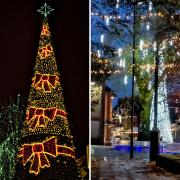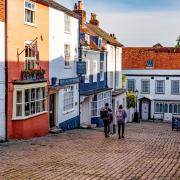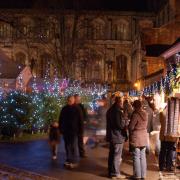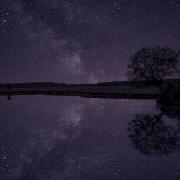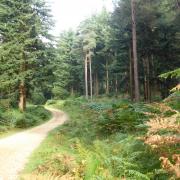Spend some time in the New Forest and you may notice a surreal, dreamlike quality to its landscape. Gnarled woodland crisscrossed by meandering streams, coastal salt marshes teeming with rare plants and birds, yellow and purple heathland inhabited by feral ponies – all squeezed into an area less than a quarter of the size of the Lake District.
This now-unique climate offers a glimpse into Great Britain’s pre-industrial geography, a rich diversity of habitats that renders the name ‘New Forest’ something of a misnomer – it is definitely not new, and it is only 36 per cent covered by trees. Its abundance of natural charm means that the New Forest has for decades attracted photographers and filmmakers, many of whom have captured its flora and fauna to spectacular effect.

One such photographer is Steve Poole, who, after travelling the world by sea with his wife Tricia, was emboldened to pursue a new career in photography.
Starting as a freelancer in Fleet Street, Steve’s growing skills eventually led him to carve out a niche, shooting portraits of some of the world’s biggest celebrities, from Kate Moss to Nina Simone to Sir David Attenborough. Steve’s portraits earned him a slew of awards and recognition, including being exhibited at the National Portrait Gallery where a number of his pictures now form part of their permanent collection.
As Steve’s career was at its height, and with children grown up and pursuing their own paths, he and his wife made the move to Lymington, where Steve found a new creative direction and began creating images of local people among the New Forest’s varied landscapes. His collection has now formed the basis of a new book and exhibition, which is titled: UNCOMMONERS.

PROTECTORS
Life in the New Forest is a delicate exchange between people and nature, civilisation and wilderness, modernity, and tradition. Few understand this balance as acutely as its community of commoners, agisters, and keepers who hold ancient rights to the Forest’s flora and fauna. The grazing of ponies, cattle, donkeys and mules in the open forest prevents encroachment of scrub and trees. The release of pigs into the Forest each autumn sees them gorging on acorns – which would otherwise harm the ponies and cattle.

These ancient practices help protect the New Forest’s natural processes – while the Verderers’ Court works to preserve its centuries-old culture. More recent years have seen the New Forest’s unique habitats attract others who are equally committed to protecting the things we are at most risk of losing. A growing number of naturalists, conservationists, archaeologists, and historians now call the area their home such as the two featured here; Hilde van der Huel, an archaeologist from Time Team, and verderer Clive Chatters.

ARTIFICERS
The New Forest’s combination of abundant natural resources and amenability to alternative lifestyles has given rise to a range of homespun crafts and businesses.
Florists in the region make use of native flora, while each batch of Jack Stride’s honey reflects particular characteristics of the Forest’s different areas. Artisans ranging from woodworkers to textile creators make use of locally sourced materials to make goods that are both functional and artistic.

Microbrewers, such as cider-maker Mary Louise Topp, and coffee roasters experiment with local ingredients and cater to local tastes. Cheesemakers influenced by the area’s agricultural history add to the variety of local produce on offer.
Businesses like these contribute to the economic diversity of the New Forest, representing a continuation of traditional skills adapted for modern times. Indeed, this balance of tradition and innovation is central to many of the New Forest’s blossoming cottage industries.

PROVIDERS
The New Forest’s eclectic geography and culture is mirrored by the activities and produce of local agriculture and fishing. Recent years have seen farmers expand beyond traditional livestock to include more specialised and unusual animals such as alpacas and mohair goats.

Such practices not only diversify the local economy, but also serve to broaden the community’s tastes and range of choices. The area’s fishers, meanwhile, benefit from rich, varied coastal waters that provide a range of seafood that complements these agricultural offerings. Groundskeepers are essential in maintaining the New Forest’s parks and gardens, ensuring these natural spaces support both biodiversity and recreation. This interplay of land and sea deeply influences the local culinary scene, with pubs and restaurants proudly featuring locally sourced ingredients, showcasing the unique flavours of the New Forest.

COMPETITORS
The New Forest’s varied landscapes provide the perfect stage for an array of sports and competitive activities. Jockeys find the open heaths ideal for riding at gallop, while the Forest’s rugged trails challenge mountain bikers and fell runners with natural obstacles. The region’s coastal edges provide ideal conditions for sailors and surfers, with wind and waves to test their skill and agility. Swimmers take to the Forest’s clear waters, while martial artists practise their discipline amidst its tranquil settings. The area’s contrasting terrains offer unique challenges and opportunities, pushing athletes to excel and adapt. In this environment, physical strength, technical skill and competitive spirit are honed and celebrated, making the New Forest a haven for those who seek to test their limits.

NOSTALGISTS
The New Forest has a lot to offer to people who like their engineering loud, visceral and intoxicating. Classic car enthusiasts relive the golden age of motoring as they drive its winding roads, while The National Motor Museum, founded by Lord Montagu, stands as a beacon to automotive history. Steam-powered traction engines such as the ones owned by Gemma Hirst, offer a vivid contrast between nature and industrialism.

The chug of motors, the smell of exhaust fumes and old leather blend into the Forest’s verdant surroundings, creating a unique sensory experience. In the New Forest, nostalgists like these seem to have found the perfect backdrop for their passions, and a community of like-minded people to indulge them with. Here, history is not confined to books and museums; it is out in the open, celebrated and maintained by the hands and hearts of the people who refuse to let it die.

ARTISTS
Artists of all styles seem to have found a kind of creative sanctuary in the New Forest. While some draw direct inspiration from the Forest’s landscapes and infuse their art with vivid imagery of its natural beauty, others are inspired more subtly by its quietness and the unique quality of light that the Forest offers.

World-renowned artists and local talents alike contribute to a vibrant arts scene. Their works range from literal interpretations of the Forest’s scenery to more abstract pieces influenced by the atmosphere and mood of the area’s unique environments.
The New Forest serves as a stimulus and a safe haven, a place where the act of creation is as disparate as the creators themselves. Painters, sculptors, writers, musicians and more have all chosen to base themselves in the area. This rich tradition of artistic expression adds to the cultural fabric of the New Forest, while also celebrating the myriad ways in which its singular environment continues to stir the imagination.

ENTHUSIASTS
The idea of the New Forest as a place of pleasure is nothing new. Ever since it was proclaimed a royal forest for deer hunting in 1079, hobbyists and holidaymakers have had plenty of fun on its beaches, walking trails and village streets. Today, this legacy continues as the New Forest welcomes a diverse array of enthusiasts, each finding their own form of joy and recreation amidst its landscapes. Swimmers relish the serene waters, while walkers are enchanted by the ever-changing scenery of woodlands and heaths.

Model boat makers pray for clear, windswept days, and mountain bikers hit trails in any and all weather. For many, leisurely pursuits such as these are their first introduction to the New Forest – and they are experiences that often inspire a deeper connection. It’s not uncommon for visitors, initially drawn by a hobby or a simple getaway, to find themselves so enamoured with the area’s charms that they return time and again. And some, like photographer Steve Poole, even go so far as to settle there permanently.

IN THE FRAME
Steve's stunning photography will be on display at Lymington's St Barbe Museum from May 18 to July 13. Find out more at stbarbe-museum.org.uk. To see more of Steve's collection, UNCOMMONERS is available to pre-order for £45 at steve-poole.com




